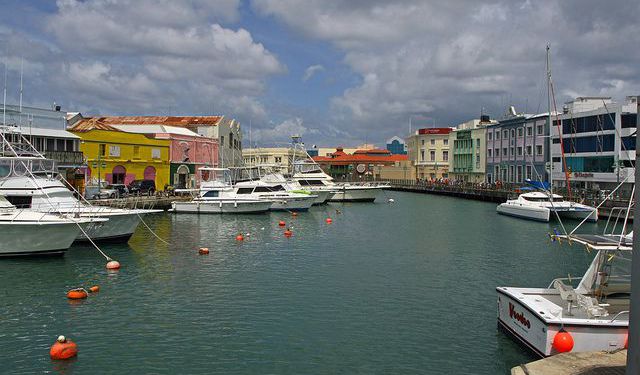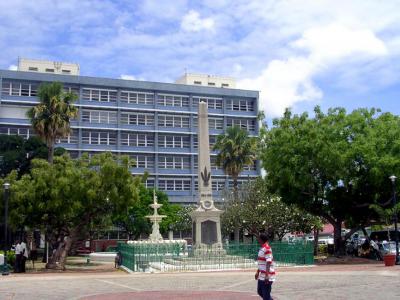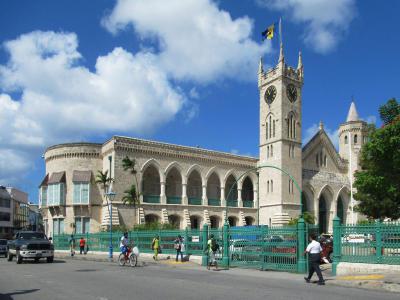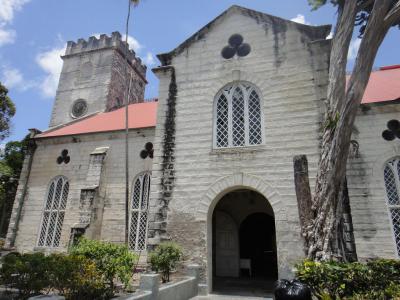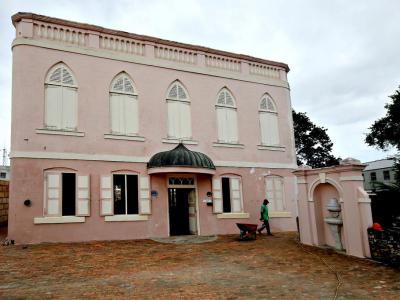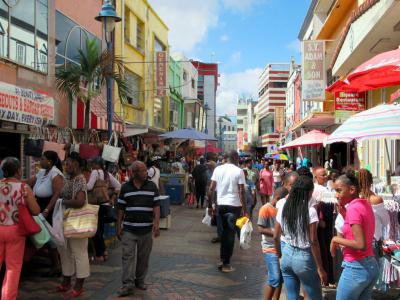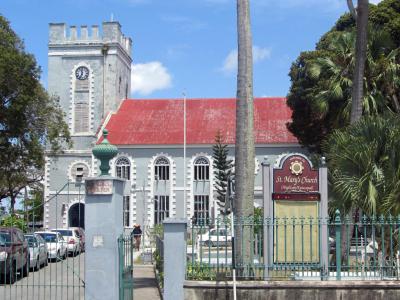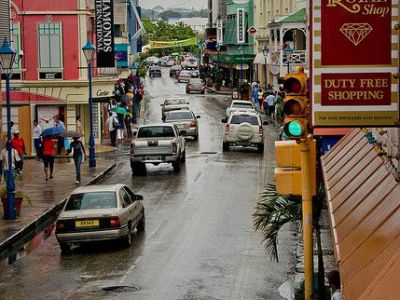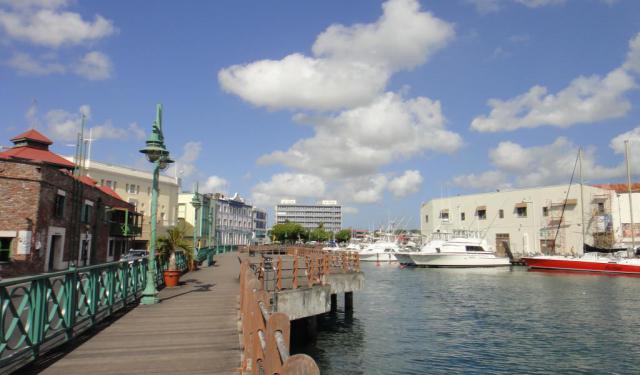Bridgetown Introduction Walking Tour (Self Guided), Bridgetown
Bridgetown is the largest city on the island of Barbados. It was founded on the shores of Carlisle Bay, a cove on the southwest coast. The harbor is the natural location for ships to anchor, and Barbados is one of the first landfall points after crossing the Atlantic from Europe.
Originally, the island of Barbados was visited by various Amerindian tribes. Evidence has shown that permanent settlement may have begun between the 4th and 7th centuries AD.
For centuries, Barbados was mostly ignored by the European powers. It's uncertain when the first European contact occurred, but it was likely the Spanish. The Portuguese came sometime between 1532 and 1536, but they abandoned Barbados by 1620.
The British arrived in 1625 and found the island uninhabited. The remains of a primitive bridge over the Careenage were believed to have been built by the Taino Indians. As a result, the area was first called Indian Bridge by the English and later the Town of Saint Michaels. St. Michael's Cathedral was originally built in 1665, but the present structure replaced it in 1789.
Bridgetown was named for Sir Tobias Bridge, who fought with Oliver Cromwell during the Interregnum and later came to the island.
The plantation economy relied on slave labor until the Slave Abolition Act of 1833. The primary crop on the island was sugar cane, a crop introduced by Jewish immigrants from Brazil. Learn more about their contributions at the Nidhe Israel Synagogue Museum.
In 1966 Barbados became an independent state within the Commonwealth, and in 2021, Barbados became a republic. Visit National Heroes Square and the Parliament Buildings and Museum to learn more about the nation's history.
Bridgetown and the Garrison are listed UNESCO World Heritage Sites. The city is a major tourist destination and cruise ship port of call, known for the gorgeous Carlisle Bay Beaches and shopping on Broad and Swan Streets. So grab your sunblock and flip-flops, and let's explore this amazing city with a self-guided walking tour.
Originally, the island of Barbados was visited by various Amerindian tribes. Evidence has shown that permanent settlement may have begun between the 4th and 7th centuries AD.
For centuries, Barbados was mostly ignored by the European powers. It's uncertain when the first European contact occurred, but it was likely the Spanish. The Portuguese came sometime between 1532 and 1536, but they abandoned Barbados by 1620.
The British arrived in 1625 and found the island uninhabited. The remains of a primitive bridge over the Careenage were believed to have been built by the Taino Indians. As a result, the area was first called Indian Bridge by the English and later the Town of Saint Michaels. St. Michael's Cathedral was originally built in 1665, but the present structure replaced it in 1789.
Bridgetown was named for Sir Tobias Bridge, who fought with Oliver Cromwell during the Interregnum and later came to the island.
The plantation economy relied on slave labor until the Slave Abolition Act of 1833. The primary crop on the island was sugar cane, a crop introduced by Jewish immigrants from Brazil. Learn more about their contributions at the Nidhe Israel Synagogue Museum.
In 1966 Barbados became an independent state within the Commonwealth, and in 2021, Barbados became a republic. Visit National Heroes Square and the Parliament Buildings and Museum to learn more about the nation's history.
Bridgetown and the Garrison are listed UNESCO World Heritage Sites. The city is a major tourist destination and cruise ship port of call, known for the gorgeous Carlisle Bay Beaches and shopping on Broad and Swan Streets. So grab your sunblock and flip-flops, and let's explore this amazing city with a self-guided walking tour.
How it works: Download the app "GPSmyCity: Walks in 1K+ Cities" from Apple App Store or Google Play Store to your mobile phone or tablet. The app turns your mobile device into a personal tour guide and its built-in GPS navigation functions guide you from one tour stop to next. The app works offline, so no data plan is needed when traveling abroad.
Bridgetown Introduction Walking Tour Map
Guide Name: Bridgetown Introduction Walking Tour
Guide Location: Barbados » Bridgetown (See other walking tours in Bridgetown)
Guide Type: Self-guided Walking Tour (Sightseeing)
# of Attractions: 7
Tour Duration: 1 Hour(s)
Travel Distance: 1.7 Km or 1.1 Miles
Author: HelenF
Sight(s) Featured in This Guide:
Guide Location: Barbados » Bridgetown (See other walking tours in Bridgetown)
Guide Type: Self-guided Walking Tour (Sightseeing)
# of Attractions: 7
Tour Duration: 1 Hour(s)
Travel Distance: 1.7 Km or 1.1 Miles
Author: HelenF
Sight(s) Featured in This Guide:
- National Heroes Square
- Parliament Buildings
- St. Michael's Cathedral
- Nidhe Israel Synagogue
- Swan Street
- St. Mary's Anglican Church
- Broad Street
1) National Heroes Square
Located between Upper Broad Street, The Wharf Road, and the Careenage, National Heroes Square is one of the centerpieces of Bridgetown. Before 1998, the square was called Trafalgar Square.
The square is dedicated to the Order of National Heroes, and National Heroes Day is celebrated on April 28. On the first commemoration of the day, Trafalgar Square was renamed for the Order. Only 11 people have made the list of National Heroes and have been given the title "The Right Excellent." Of the people on the list, only Sir Garfield Sobers, a former cricketer, and Rhianna, a singer and businesswoman, are alive today.
However, the most prominent statues in the square have been around longer than the Order. The first one to catch your eye is undoubtedly that of Lord Nelson, the famous British Royal Navy Admiral. The statue has stood here since 1813 as a memorial to the Royal Navy's victory in the Battle of Trafalgar.
This statue was dedicated 27 years before the statue of Nelson that stands over Trafalgar Square in London. Nelson's statue here has served as the geographic center for the island since it was erected. Distances have always been measured from the statue.
Other large monuments in the square include the Cenotaph War Memorial and Fountain Gardens. A large fountain commemorates the piping of water into town in 1865.
With its location at the center of town, the square is a great place to spot other attractions. You can see the Barbados Parliament Buildings, the Department of Inland Revenue, and the Chamberlain Bridge.
The square is dedicated to the Order of National Heroes, and National Heroes Day is celebrated on April 28. On the first commemoration of the day, Trafalgar Square was renamed for the Order. Only 11 people have made the list of National Heroes and have been given the title "The Right Excellent." Of the people on the list, only Sir Garfield Sobers, a former cricketer, and Rhianna, a singer and businesswoman, are alive today.
However, the most prominent statues in the square have been around longer than the Order. The first one to catch your eye is undoubtedly that of Lord Nelson, the famous British Royal Navy Admiral. The statue has stood here since 1813 as a memorial to the Royal Navy's victory in the Battle of Trafalgar.
This statue was dedicated 27 years before the statue of Nelson that stands over Trafalgar Square in London. Nelson's statue here has served as the geographic center for the island since it was erected. Distances have always been measured from the statue.
Other large monuments in the square include the Cenotaph War Memorial and Fountain Gardens. A large fountain commemorates the piping of water into town in 1865.
With its location at the center of town, the square is a great place to spot other attractions. You can see the Barbados Parliament Buildings, the Department of Inland Revenue, and the Chamberlain Bridge.
2) Parliament Buildings (must see)
The Parliament Building sits just north of the Careenage on Broad and Rickett Streets. The building was built between 1870 and 1874, but the island's Parliament was established in 1639. That makes it the third oldest Parliament in the Commonwealth. The building is a protected building and part of the UNESCO World Heritage Site of Historic Bridgetown.
The oldest part of the neo-Gothic Victorian-style building is the East Wing, completed in 1873. This is where the chambers of the Senate and House of Assembly are located, which still meet weekly. Over the years, many other offices have been here, too, including the post office, central bank, and public library.
Inside the House of Assembly chambers, you can see stained glass windows showing British sovereigns from the time of James I up to Queen Victoria. In the Senate, the windows show the armorial bearings of past Presidents of the Council and Speakers of the House of Assembly.
The West Wing currently houses the National Heroes Gallery and the Museum of Parliament. In the past, it has housed offices for government officials like the Colonial Secretary and Treasurer, Provost Marshal, and Comptroller of Customs.
The clocktowers and bells above the West Wing were originally located on the East Wing but were moved in 1886. Poor soil at the previous location caused the tower to begin to sink within ten years of being built. The tower is built from coral limestone and is a prominent landmark throughout town.
The oldest part of the neo-Gothic Victorian-style building is the East Wing, completed in 1873. This is where the chambers of the Senate and House of Assembly are located, which still meet weekly. Over the years, many other offices have been here, too, including the post office, central bank, and public library.
Inside the House of Assembly chambers, you can see stained glass windows showing British sovereigns from the time of James I up to Queen Victoria. In the Senate, the windows show the armorial bearings of past Presidents of the Council and Speakers of the House of Assembly.
The West Wing currently houses the National Heroes Gallery and the Museum of Parliament. In the past, it has housed offices for government officials like the Colonial Secretary and Treasurer, Provost Marshal, and Comptroller of Customs.
The clocktowers and bells above the West Wing were originally located on the East Wing but were moved in 1886. Poor soil at the previous location caused the tower to begin to sink within ten years of being built. The tower is built from coral limestone and is a prominent landmark throughout town.
3) St. Michael's Cathedral (must see)
Two blocks east of National Heroes Square, this Anglican church has stood since 1789. It replaced an earlier wooden church built in 1665 that was destroyed by a hurricane in 1780. That first church was located at the site of present-day Saint Mary's Church.
The cathedral is made of coral limestone and features beautiful stained glass windows. In 1938, the Chapel of the Blessed Sacrament was added. The marble baptismal font is from the 17th century. The impressive structure can seat about 1,600 people and has one of the largest pipe organs in the Caribbean.
The church was originally the Saint Michael's Parish Church but was elevated to cathedral status in 1825 when Bishop Coleridge became head of the new Diocese of Barbados and the Leeward Islands.
Some of the most striking stained glass pieces can be seen in the Chapel. The central circular window features the image of Saint Michael. The larger windows to the left and right commemorate the parents of James Challenor Lynch. The windows were made in the late 1800s in London.
In the graveyard, you can see some of Barbados' famous public figures' graves. Sir Grantley Adams, the first chief minister and the only Prime Minister of the West Indies Federation, rests here. His son Tom Adams, the island's second prime minister, is also here.
The cathedral is made of coral limestone and features beautiful stained glass windows. In 1938, the Chapel of the Blessed Sacrament was added. The marble baptismal font is from the 17th century. The impressive structure can seat about 1,600 people and has one of the largest pipe organs in the Caribbean.
The church was originally the Saint Michael's Parish Church but was elevated to cathedral status in 1825 when Bishop Coleridge became head of the new Diocese of Barbados and the Leeward Islands.
Some of the most striking stained glass pieces can be seen in the Chapel. The central circular window features the image of Saint Michael. The larger windows to the left and right commemorate the parents of James Challenor Lynch. The windows were made in the late 1800s in London.
In the graveyard, you can see some of Barbados' famous public figures' graves. Sir Grantley Adams, the first chief minister and the only Prime Minister of the West Indies Federation, rests here. His son Tom Adams, the island's second prime minister, is also here.
4) Nidhe Israel Synagogue (must see)
The Nidhe Israel Synagogue is the only synagogue on the island and one of the oldest in the western hemisphere. It was built in 1654. Jews left Dutch Brazil to avoid persecution from the Portuguese and settled on the island. They were skilled in the sugar industry and introduced the sugar crop to Barbados, teaching their skills to the local land owners.
The Barbados Jewish community grew over the years as other settlements dissolved. One group came from Cayenne, French Guana, in 1664, and another from Suriname in 1674. They gathered in two communities on the island, the largest being in Bridgetown, where 54 out of 404 households were Jewish.
The building has gone through many phases. Like other buildings on the island, hurricanes have damaged it over the centuries. It was destroyed by one in 1831 and rebuilt afterward. Unfortunately, it fell into disrepair until it was sold in 1929.
The building was modified, with the upper gallery being converted to a full second level. Over the years, the building changed hands several times until 1983, when the government seized it. The plan was to bulldoze the site and build a new courthouse, but petitioning from the local Jewish community resulted in it being handed over to the Barbados National Trust.
A full renovation began in 1986, and the building returned to being a synagogue. Archaeologists discovered a mikveh on the site of the former rabbi's house in 2008. A mikveh is a ritual bath, and it was constructed over a still-running freshwater spring.
The Nidhe Israel Museum opened in 2008 to tell the story of the Jewish communities on the island and their histories.
The Barbados Jewish community grew over the years as other settlements dissolved. One group came from Cayenne, French Guana, in 1664, and another from Suriname in 1674. They gathered in two communities on the island, the largest being in Bridgetown, where 54 out of 404 households were Jewish.
The building has gone through many phases. Like other buildings on the island, hurricanes have damaged it over the centuries. It was destroyed by one in 1831 and rebuilt afterward. Unfortunately, it fell into disrepair until it was sold in 1929.
The building was modified, with the upper gallery being converted to a full second level. Over the years, the building changed hands several times until 1983, when the government seized it. The plan was to bulldoze the site and build a new courthouse, but petitioning from the local Jewish community resulted in it being handed over to the Barbados National Trust.
A full renovation began in 1986, and the building returned to being a synagogue. Archaeologists discovered a mikveh on the site of the former rabbi's house in 2008. A mikveh is a ritual bath, and it was constructed over a still-running freshwater spring.
The Nidhe Israel Museum opened in 2008 to tell the story of the Jewish communities on the island and their histories.
5) Swan Street
Swan Street parallels Broad Street to the north. It's a narrow alleyway of a street lined with shops and restaurants. It's pedestrian-only, so while it can be quite crowded, it's a great place to wander to meet the locals. There are several electronics stores, home goods, a shopping mall, and takeaway restaurants.
The buildings on Swan Street are traditional homes, with the businesses built on the lower levels. At one time, the street was known as Jew's Street because of the community's successful Jewish merchants. Many of the shopkeepers lived in the upper stories of the buildings. Unfortunately, a major fire swept through the area in 1845. After which, the street was part of what the locals dubbed the Burnt District.
Today, you'll see businesses and haberdasheries from around the world here. But the upper levels are no longer homes. Instead, they are mostly used as warehouses now.
Historians are unsure how the street got its official name. Some suggest that there was an inn named The Swan. Others say it was s tribute to a local surveyor, Captain Swan.
It's a busy place, favored by the locals more than the tourists. Swan Street is a must-see if you're looking for island goods and good prices. This street keeps the Barbadian spirit alive--you can find everything here, from fresh fruit and veggies to local island jewelry and crafts.
The buildings on Swan Street are traditional homes, with the businesses built on the lower levels. At one time, the street was known as Jew's Street because of the community's successful Jewish merchants. Many of the shopkeepers lived in the upper stories of the buildings. Unfortunately, a major fire swept through the area in 1845. After which, the street was part of what the locals dubbed the Burnt District.
Today, you'll see businesses and haberdasheries from around the world here. But the upper levels are no longer homes. Instead, they are mostly used as warehouses now.
Historians are unsure how the street got its official name. Some suggest that there was an inn named The Swan. Others say it was s tribute to a local surveyor, Captain Swan.
It's a busy place, favored by the locals more than the tourists. Swan Street is a must-see if you're looking for island goods and good prices. This street keeps the Barbadian spirit alive--you can find everything here, from fresh fruit and veggies to local island jewelry and crafts.
6) St. Mary's Anglican Church
You'll find Saint Mary's Church at the junction of Cheapside Road, Harts Street, and Suttle Street, directly across from the Old Town Hall. This is an active church serving Bridgetown, but it feels like a rural parish church even in the hustle of the big city.
Part of this church's charm comes from its lovely grounds, protected from the outside world by a simple wrought iron fence. In addition, the colonial style adds to the ambiance, making one feel like they're in a rural parish in England.
The building is next to the Jubilee Garden, which was built to commemorate Queen Victoria's golden jubilee. The garden was abandoned and used as a bus terminal for some years but was restored to its former glory in 2005.
The site of Saint Mary's is where the first church was built on the island back in 1641. That wooden church was Saint Michael's, and a hurricane destroyed it in 1780. Even before the storm, however, the decision to move Saint Michael's had been made.
After Saint Michaels was moved, this site sat vacant for 45 years. Finally, in 1825, the legislature decided to build a new church here, and Saint Mary's Church was consecrated in 1827.
Several local persons of note are buried here, including National Hero Samual Jackman Prescod, the first non-white person elected to Parliament. On the east end of the church grounds, you can find the Justice Tree. This large cotton tree was, at one time, the site of public hangings.
Part of this church's charm comes from its lovely grounds, protected from the outside world by a simple wrought iron fence. In addition, the colonial style adds to the ambiance, making one feel like they're in a rural parish in England.
The building is next to the Jubilee Garden, which was built to commemorate Queen Victoria's golden jubilee. The garden was abandoned and used as a bus terminal for some years but was restored to its former glory in 2005.
The site of Saint Mary's is where the first church was built on the island back in 1641. That wooden church was Saint Michael's, and a hurricane destroyed it in 1780. Even before the storm, however, the decision to move Saint Michael's had been made.
After Saint Michaels was moved, this site sat vacant for 45 years. Finally, in 1825, the legislature decided to build a new church here, and Saint Mary's Church was consecrated in 1827.
Several local persons of note are buried here, including National Hero Samual Jackman Prescod, the first non-white person elected to Parliament. On the east end of the church grounds, you can find the Justice Tree. This large cotton tree was, at one time, the site of public hangings.
7) Broad Street
Located in the heart of Bridgetown, Broad Street serves as the city’s central commercial artery, bustling with activity and rich in history. This prominent thoroughfare is the epicenter of shopping, finance, and dining, making it a prime destination for both locals and visitors.
Historically, Broad Street was once part of a longer and narrower street known as Cheapside. Today, Cheapside lies at the western end of the city, home to the General Post Office and Cheapside Market. Broad Street itself has evolved into a vibrant commercial hub, drawing in shoppers with its array of duty-free stores, high-end jewelry boutiques, and major department stores. Well-known retailers such as Cave Shepherd & Company, Harrisons, Diamonds International, Colombian Emeralds, and Little Switzerland line the street, offering everything from luxury goods to everyday essentials.
In addition to its reputation as a shopping destination, Broad Street houses several key financial institutions. Major commercial banks, including the Royal Bank of Canada, Republic Bank of Trinidad and Tobago, FirstCaribbean International Bank Ltd, Barbados National Bank Ltd, Bank of Nova Scotia, and Butterfield Bank, have their main branches here. The presence of these institutions solidifies Broad Street’s role as a financial hub in the capital city.
Broad Street is also an architectural showcase, featuring a mix of modern and historic buildings. It is divided into Upper and Lower Broad Street, with Upper Broad Street near the well-known Lord Nelson Statue and Lower Broad Street situated near the Old Mutual Building, an architectural landmark that now houses a branch of Butterfield Bank. The street stretches from Saint Mary’s Church and the Old Town Hall on its western side to Bridge Street, close to National Heroes Square and the Parliament Buildings. Running parallel to Constitution River, it offers easy access to harbor cruises and boat rides along the waterfront.
A hive of daily activity, Broad Street is particularly popular among tourists, many of whom arrive from the nearby cruise ship port. However, visitors should note that most shops close on Sundays. Despite this, the street remains an essential part of the Bridgetown experience, offering a seamless blend of commerce, history, and vibrant city life.
Historically, Broad Street was once part of a longer and narrower street known as Cheapside. Today, Cheapside lies at the western end of the city, home to the General Post Office and Cheapside Market. Broad Street itself has evolved into a vibrant commercial hub, drawing in shoppers with its array of duty-free stores, high-end jewelry boutiques, and major department stores. Well-known retailers such as Cave Shepherd & Company, Harrisons, Diamonds International, Colombian Emeralds, and Little Switzerland line the street, offering everything from luxury goods to everyday essentials.
In addition to its reputation as a shopping destination, Broad Street houses several key financial institutions. Major commercial banks, including the Royal Bank of Canada, Republic Bank of Trinidad and Tobago, FirstCaribbean International Bank Ltd, Barbados National Bank Ltd, Bank of Nova Scotia, and Butterfield Bank, have their main branches here. The presence of these institutions solidifies Broad Street’s role as a financial hub in the capital city.
Broad Street is also an architectural showcase, featuring a mix of modern and historic buildings. It is divided into Upper and Lower Broad Street, with Upper Broad Street near the well-known Lord Nelson Statue and Lower Broad Street situated near the Old Mutual Building, an architectural landmark that now houses a branch of Butterfield Bank. The street stretches from Saint Mary’s Church and the Old Town Hall on its western side to Bridge Street, close to National Heroes Square and the Parliament Buildings. Running parallel to Constitution River, it offers easy access to harbor cruises and boat rides along the waterfront.
A hive of daily activity, Broad Street is particularly popular among tourists, many of whom arrive from the nearby cruise ship port. However, visitors should note that most shops close on Sundays. Despite this, the street remains an essential part of the Bridgetown experience, offering a seamless blend of commerce, history, and vibrant city life.
Walking Tours in Bridgetown, Barbados
Create Your Own Walk in Bridgetown
Creating your own self-guided walk in Bridgetown is easy and fun. Choose the city attractions that you want to see and a walk route map will be created just for you. You can even set your hotel as the start point of the walk.
Garrison Historic Area Walking Tour
St. Ann's Garrison, more commonly known simply as "The Garrison", is a small district in Barbados situated some 2 miles south of Heroes Square in the capital-city of Bridgetown.
This historic area is dominated by a horse racetrack, located on the 30 acre parade ground called the Garrison Savannah. Here, in the mid 18th century, wealthy prominent Barbadians and regiment troops... view more
Tour Duration: 1 Hour(s)
Travel Distance: 1.7 Km or 1.1 Miles
This historic area is dominated by a horse racetrack, located on the 30 acre parade ground called the Garrison Savannah. Here, in the mid 18th century, wealthy prominent Barbadians and regiment troops... view more
Tour Duration: 1 Hour(s)
Travel Distance: 1.7 Km or 1.1 Miles
The Most Popular Cities
/ view all
